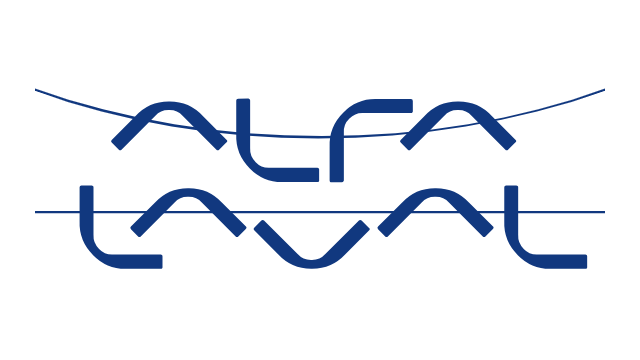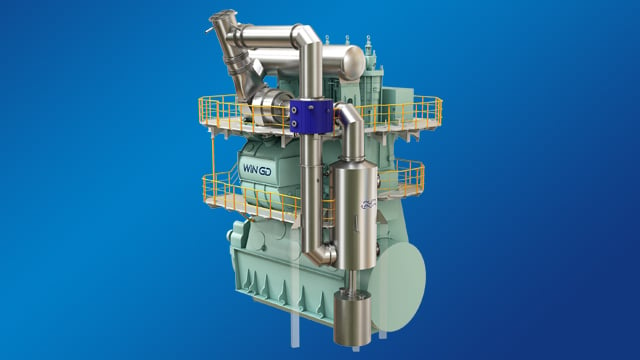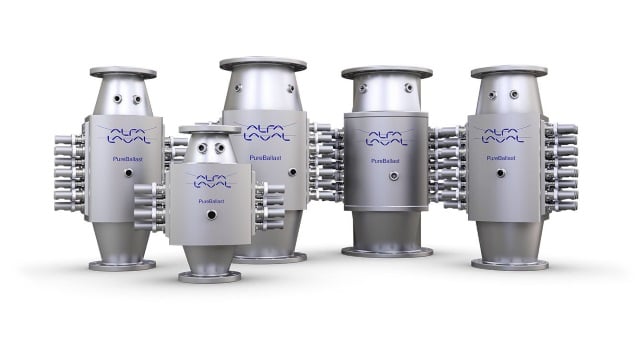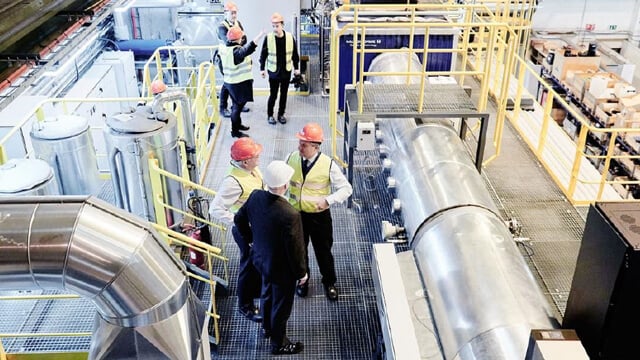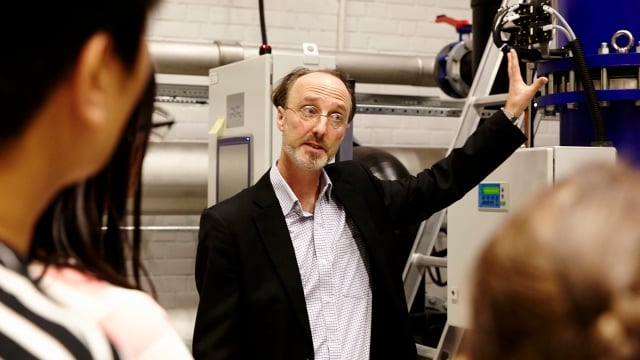2015-04-01 Product news
Meeting demand for sulphur emissions control technology
Demand for sulphur emissions control technology is steadily increasing and, in all likelihood, will accelerate as the 2015 deadline for meeting low-sulphur regulatory requirements approaches. There are three main solutions for exhaust emissions compliance: the use of low sulphur fuel, the use of heavy fuel oil (HFO) with exhaust gas cleaning systems, or the use of liquefied natural gas (LNG). Each solution comes with pros and cons that require careful consideration. However, one thing is clear: Ship owners with the highest level of preparedness stand to gain from advance planning by limiting disruption to business.
Retrofitting vessels with new technologies to meet regulations, such as the International Maritime Organization (IMO) Annex VI - Prevention of Air Pollution from Ships, is one of the greatest challenge facing ship owners today. Ship owners will not only be required to make hard and fast decisions about the best and most cost-effective technology to suit their requirements, but to identify trustworthy partners with the expertise and capabilities to execute these retrofit projects and sometimes do so within a relatively short timeframe. But perhaps there is an even more important question: Once the tough technology decisions have been made, will ship owners be able to find suppliers and shipyards with proven track records to meet the burgeoning demand?
Making the right sulphur emissions control choice
There has been much discussion about the best way forward. On the one hand, while the use of low-sulphur fuel (MGO) offer ready relief, the higher fuel prices may turn out to a be costly solution in the long run. On the other hand, while industry studies point to the use of LNG as a sound long-term solution, the infrastructure is still in the early stages of development; in addition, LNG fuel prices are uncertain and the potential loss of cargo space when retrofitting is undesirable.
That leaves exhaust gas cleaning as an alternative that offers ship owners with trade routes in emission control areas (ECAs) a commercially viable option to meet the upcoming 0.1% sulphur emissions regulations in 2015. It is also a sound option for all ship owners looking to retrofit vessels to comply with the global 0.5% sulphur emissions limit in 2020.
Among the early adopters of exhaust gas cleaning technology is DFDS Seaways. It was important for DFDS to assess the costs and benefits of sulphur emissions control technology due to the company’s operational profile and trade routes on the North Sea, English Channel and Baltic Sea. The shipping company first began testing the Alfa Laval PureSOx exhaust gas cleaning system onboard its Ro-Ro vessel, MV Ficaria Seaways, in 2009. As with any early test release, there were initial hiccups but these were later overcome. Today, DFDS’ plan for sulphur emissions control is weighted heavily in favour of exhaust gas cleaning systems.
Capabilities that breed confidence
As one of the largest shipyards in Europe in terms of capacity and service range, Remontowa Shipyard was selected by DFDS for the retrofit projects. Remontowa specializes in ship conversions and repairs, newbuilding design and construction, steel structures including ship hulls and ship sections, as well as a wide range of offshore projects. Retrofitting the three DFDS ships with Alfa Laval PureSOx exhaust gas cleaning systems were among the 200 projects that the shipyard routinely handles each year.
In July and August of this year, Remontowa completed the retrofit of the three DFDS vessels with four Alfa Laval PureSOx systems according to schedule. A single-inlet PureSOx system was installed on the MV Petunia Seaways and another single-inlet system on the M/V Magnolia Seaways. Both are sister ships to the MV Ficaria Seaways, and each is powered by a MAN 9L60MC-C main engine, providing an output of 21 MW. Two single-inlet systems clean the exhaust gas from two GMT Sulzer 9ZA 50S engines, which provide a combined output of 21.6 MW, on the MV Selandia Seaways. The systems enable the vessels to continue to use heavy fuel oil with high sulphur content, yet comply with current and future sulphur oxides (SOx) emissions limits.
“With the DFDS retrofitting project, we gained invaluable experience and stand fully prepared to help ship owners retrofit their vessels with sulphur abatement technologies such as exhaust gas cleaning systems,” says Marcin Madrala, Remontowa’s Commercial Manager.
As with most retrofit projects, refitting the DFDS vessels with Alfa Laval PureSOx presented challenges. Remontowa’s design engineers and contractors, in cooperation with DFDS and Alfa Laval, were able to achieve minimal changes to the existing ship arrangements and operation while ensuring cost-effective installation.
According to Madrala, Remontowa has some 3,500 employees and dedicated contractors who provide engineering services and support throughout all phases of retrofit. Of these are more than 100 engineers who staff the shipyard’s design office. The depth and breadth of in-house expertise lends itself to the innovative problem solving required within the short timeframe allotted for retrofits.
“Proper preparation and good supervision are givens,” Madrala explains. “But critical thinking and the ability to adapt are also essentials. Often conditions onboard prove to be structurally different than the ship blueprints. So despite good planning, it can be difficult – if not impossible – to anticipate issues that can arise. That is why thinking on your feet, close collaboration with ship owner and supplier and open communications are key elements for retrofit success.”
Proven, reliable and flexible system
The Alfa Laval PureSOx system offers key advantages for shipyards and ship owners alike. Among them are a proven track record, high reliability, great installation and operational flexibility, and global service and support. This unique, highly effective hybrid system removes sulphur from ship engine exhaust gas onboard all vessel types.
On the MV Ficaria, for instance, the system effectively removes sulphur from the exhaust gas of engines using heavy fuel oil, bringing sulphur emissions to a level below 0.1%. The PureSOx system has been in operation for more than 11,500 hours, cleaning up to 200,000 kilograms of exhaust gas per hour.
With its relatively compact footprint, PureSOx makes installation feasible. Installation flexibility is most evident, however, in the multiple-inlet system that facilitates connection of the PureSOx system to both main and auxiliary engines. This provides significant equipment and installation savings, thereby reducing overall investment costs. The multiple-inlet system also makes the best use of available space where single-inlet systems simply will not fit and, due to its reduced weight, prevents potential stability issues.
Such a multiple-inlet system was installed on the Plyca, a Spliethoff Group Con-Ro vessel. PureSOx has proven itself through more than 6,000 hours of fully IMO-compliant operation onboard, and it continues to deliver space, energy and maintenance savings.
Beyond maritime equipment expertise
Cost savings such as these help boost the bottom line of ship owners around the world. That is why meeting energy efficiency and environmental regulatory demands are critical to the success of the maritime industry. The company has spent decades of work on incorporating innovative heat transfer, separation and fluid handling technologies for critical onboard operations. Alfa Laval technologies, such as PureSOx help create cost-effective solutions that benefit both the environment and ship owner profitability.
“Alfa Laval expertise, however, extends beyond the provision of proven marine equipment,” says Peter Leifland, President, Alfa Laval Marine & Diesel Division. “Working with shipyards, ship owners and ship operators for as long as Alfa Laval have has provided us with deep insights into the challenges the industry is facing.”
Leifland goes on to say that no matter the challenge, Alfa Laval works tirelessly not only to innovate solutions that address these challenges but also help maritime stakeholders assess their options and determine the best way forward.
“Our job is to make sure that Alfa Laval solutions fit on board yet deliver long-term economy, reliability, simple installation, great operating flexibility and infrequent maintenance,” Leifland notes. “But when all is said and done, we also make sure that we continue to optimize the performance of our equipment through global service and support.”
Moving forward to 2015
As the 2015 deadline for compliance with the 0.1% sulphur emission limit in certain ECAs draws near, ship owners and operators must identify reliable partners who can ensure that ship operation meets strict regulations. With its vast expertise and solid experience from the recent DFDS retrofits, Remontowa and Alfa Laval are well positioned to assist other ship owners with the supply and installation of exhaust gas cleaning systems.
Remontowa’s Madrala shares following lessons learned from retrofitting the DFDS vessels:
• Prepare well in advance using the highest possible standards and procedures
• Establish good communications with all parties involved
• Be clear about expectations and goals
• Communicate openly at every phase in order to ensure unexpected issues can be resolved in a timely manner
“We worked closely with Alfa Laval and received solid support for these retrofit projects,” affirms Remontowa’s Madrala. “This worked to our client’s advantage because both Remontowa and Alfa Laval share a common aim: to deliver the best and most cost-effective services that will ensure client satisfaction.”
For those ship owners and operators, especially those with main trade routes in emission control areas, these words demonstrate the strong commitment by Remontowa and Alfa Laval toward ship owner success. Should the combination of Remontowa’s high level of preparedness and Alfa Laval’s proven exhaust gas cleaning system prove to be the right choice for one or several of your vessels, you stand to limit disruption to your business while making big gains from advance planning.
In the near future, demand for retrofitting vessels with exhaust gas cleaning systems will be great, but the supply of reliable shipyards and reliable equipment from a reliable supplier may not be. Act now to ensure compliance.
DFDS exhaust gas cleaning retrofit projects completed by Remontowa Shipyard
|
Vessel |
Year built |
Year rebuilt |
Class |
Main engines |
|
MV Petunia Seaways |
2004 |
2013 |
LR+100 A1 RoRo |
MAN 9L60MC-C |
|
MV Primula Seaways |
2004 |
2013 |
LR+100 A1 RoRo |
MAN 9L60MC-C |
|
MV Selandia Seaways |
1998 |
2013 |
DNV 1 A1 |
2 x Wärtsilä New Sulzer Diesel 9ZA 50 S, 10.800 kW each |
|
Vessel |
Output power |
Deadweight tonnage |
Length |
Average speed |
|
MV Petunia Seaways |
21 MW |
10,407 tonnes |
30 m |
17.6 knots |
|
MV Primula Seaways |
21 MW |
10,407 tonnes |
27 m |
18.5 knots |
|
MV Selandia Seaways |
21.6 MW |
11,089 tonnes |
26 m |
17.5 knots |
DFDS Seaways
Headquarters: Copenhagen, Denmark
Founded: 1866
Fleet: About 50 vessels on 30 routes in the Baltic Sea, North Sea and English Channel
www.dfdsseaways.com
Remontowa Shipyard
Headquarters: Gdańsk, Poland
Founded: 1952
Employees: 3,500 including dedicated contractors
www.remontowa.com.pl
Editor’s notes
About Alfa Laval
Alfa Laval is a leading global provider of specialized products and engineering solutions based on its key technologies of heat transfer, separation and fluid handling.
The company’s equipment, systems and services are dedicated to assisting customers in optimizing the performance of their processes. The solutions help them to heat, cool, separate and transport products in industries that produce food and beverages, chemicals and petrochemicals, pharmaceuticals, starch, sugar and ethanol.
Alfa Laval’s products are also used in power plants, aboard ships, in the mechanical engineering industry, in the mining industry and for wastewater treatment, as well as for comfort climate and refrigeration applications.
Alfa Laval’s worldwide organization works closely with customers in nearly 100 countries to help them stay ahead in the global arena.
Alfa Laval is listed on Nasdaq OMX, and, in 2012, posted annual sales of about SEK 29.8 billion (approx. 3.5 billion Euros). The company has today about 16 400 employees.
